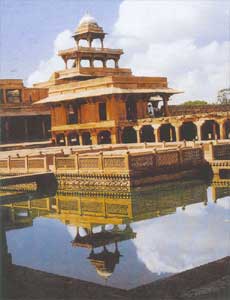Fatehpur Sikri, Agra
In honour of saint Shaikh Salim Chishti, the Mughal emperor Akbar, the great, founded a magnificent city on Sikri ridge. In 1571 he ordered the construction of buildings for his own use and asked the noblemen to built houses for themselves. Within a year, most of the work was finished and within the next few years, a well planned city with administrative, residential and religious buildings came into existence.
The Jami Mosque was perhaps among the first buildings to come up. Its epigraph provides AH 979 (AD 1571-1572) as the date of its completion. The Buland Darwaza was added some five years later.
Among other important buildings are the tomb of Shaikh Salim Chishti, the Naubat-or-Naqqar Khana (drum-house), Taksal (mint), Karkhanas (royal workshops), Khazana (treasury), Hakim's quarters, Diwan-i-Am (hall of public audience), house of Maryam also called Sunahra Makan (Golden House), palace of Jodha Bai, Birbal's house etc.
Fatehpur Sikri was Akbar's capital for approximately 12 years. Akbar selected Sikri as the seat of his government believing it to be auspicious for himself. He experimented both with architecture and art and built a city expressing his ideals and vision. Today, Fatehpur Sikri is a deserted, phantom city. But the inner citadel is immaculately preserved. The finest monuments within this area are the Diwan-i-Am, Diwan-i-Khas, Panch Mahal, Buland Darwaza and the tomb of Saint Sheikh Salim Chishti, and the Jama Masjid (one of the largest mosques In India).
Timings: 9.00 a.m - 6.00 p.m
Open on all weekdays
Open on all weekdays

No comments:
Post a Comment